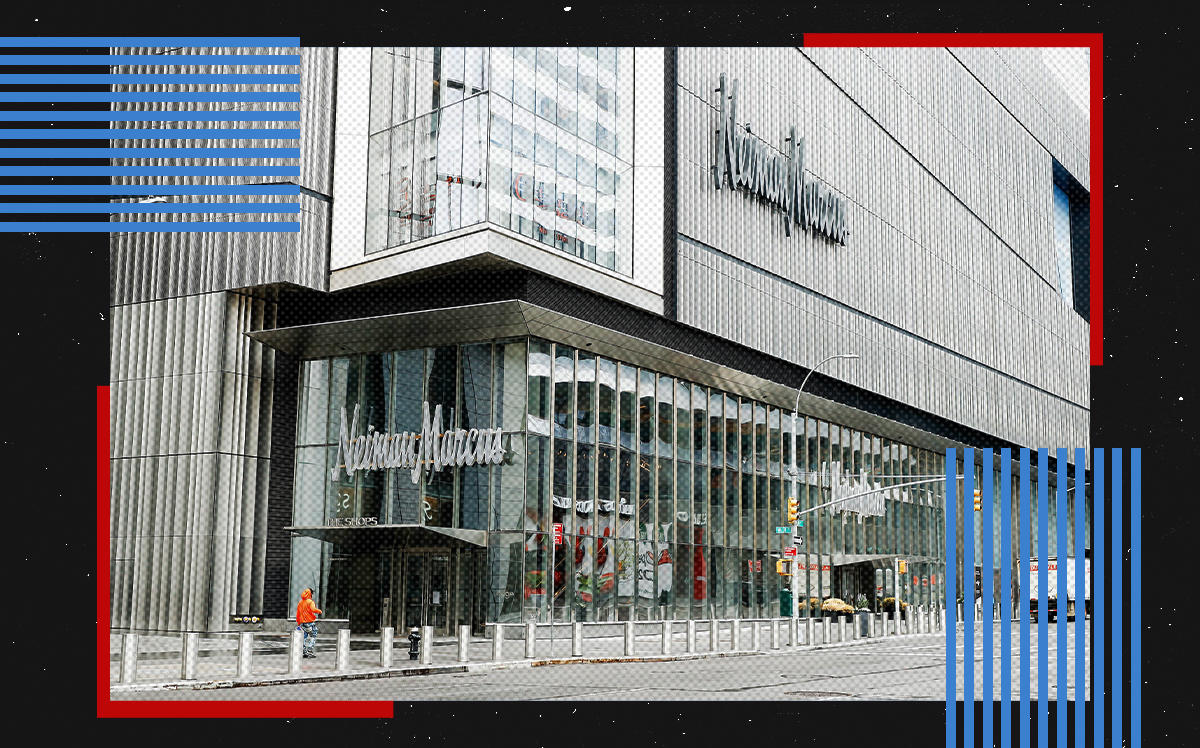UPDATED Aug. 16, 2020, 2:50 pm: When Neiman Marcus signed a lease to take over a massive space in Hudson Yards’ mall, the luxury department store committed to an ambitious 50 years there.
Sixteen months later, and with more than 17,000 days left on the lease, the embattled retailer walked away late last month, closing three other locations across the country at the same time, according to bankruptcy filings.
Neiman was one of roughly at least six major retailers to file for Chapter 11 in May, followed by dozens more in the months after.
It’s a stunning loss for developers Related Companies and Oxford Properties, which invested heavily in bringing Neiman to their $25 billion megaproject.
“There’s the first phase of leasing in a project like this where the [developers] get the big anchor and then they try to lure in other tenants that are of the same sort of zeitgeist,” Jacqueline Klinger, a partner at the Shopping Center Group, who brokered Sweetgreen’s deal at Hudson Yards and Whole Foods’ lease across the street.
With Neiman at its center, the high-end mall at Hudson Yards was marketed as a hub where tourists and wealthy residents living in nearby luxury condos could come to shop or enjoy cocktails after work. An elaborate launch party was held. Liza Minnelli sang to the crowd — a rendition of “New York, New York.”
Today, the mall is closed and any sense of nostalgia about the city’s past has been eclipsed by existential dread. What is New York anymore? Midtown is empty. Shops are closed. The city’s hallmark features — tourists, noise, activity — have dimmed.
To some, that’s a good thing. But in the struggling retail sector, the pandemic has accelerated downward trends that were percolating for years, forcing debt-laden landlords to reimagine their spaces, and fast. One retail data firm, Coresight Research, estimates the pandemic could result in the closures of 25,000 stores across the country.
Flagship stores are shaping up to be collateral damage: Once considered a vital component of a store’s branding, many are now closing for good. Since mid-March, both McDonalds and Microsoft have shuttered their New York flagships. On Fifth Avenue, where vacant luxury stores are sealed shut with wooden boards, Valentino is fighting to terminate its flagship lease.
In July, Neiman Marcus joined their ranks.
“Customers are and will continue to shop differently than they did prior to the pandemic,” Neiman Marcus’s vice president, Amber Seikaly, predicted when she announced the news of the company’s Hudson Yards store closing.
Related Companies responded that it was “unfortunate that Neiman Marcus was unable to achieve the success that other retailers have found at Hudson Yards.”
Lowering the flag
Flagship stores have always been a risky play: Major retailers pour millions of dollars into leases in high-end locations like Fifth Avenue and Soho, banking on the idea that prominence is priceless.
In reality, many of these locations don’t make much money and cost a lot to maintain.

Related’s Steve Ross (Getty)
Even before the pandemic, countless retailers were facing a reckoning about whether the value of notability was enough to justify the costs, particularly as more people started shopping online.
“Many of the flagships, they really got caught into this concept of bigger is better, and that’s not really the case,” said Robert Burke, CEO of his eponymous retail brokerage. “While it might have been the trend, five years ago, 10 years ago, 15 years ago, it is not what is motivating the consumer today.”
When Neiman agreed to set up shop at Hudson Yards, the Texas-based company was already having financial problems. To broker a deal, Related and Oxford agreed to cover most of the costs of building out the 190,000 square-foot location, according to a source familiar with the matter, and allowed the retailer to pay a portion of sales in exchange for rent.
“They pretty much paid for everything with this deal,” the source said.
Representatives for Related and Oxford did not respond to requests for comment.
Many of the flagships, they really got caught into this concept of bigger is better, and that’s not really the case. — Robert Burke, Robert Burke Associates
Since then, the gradual shift away from showy flagships has only accelerated. In January, Coach abruptly closed its Madison Avenue location after occupying the space for more than 30 years, following the lead of Tommy Hilfiger, which left Fifth Avenue in 2019.
In 2019’s second quarter, Manhattan retail leasing activity tumbled downward after two years of positive momentum. Total velocity in the first quarter this year was down four percent, with pop-ups and short-term leases dominating over new flagships — encompassing nearly 42 percent of apparel transactions, according to a CBRE report.
In the second quarter of 2020, East 57th to 72nd of Madison Avenue saw a recent record high of nearly 33 percent availability. Fifth Avenue availability has similarly sat in the low 20 percent range, according to market snapshots by Cushman & Wakefield.
For luxury retailers in particular, it seems as if landlords on Fifth Avenue dug themselves into their own grave. Rather than slashing rents to avoid vacancies, landlords cut checks for interior redesigns, moving costs and other expenses.
For Nike’s 650 Fifth Avenue deal, SL Green Realty and Jeff Sutton’s Wharton Properties offered to take over the sportswear retailer’s Trump Tower lease and construct a basketball court inside the store, in addition to buying Juicy Couture, Devon & Blakely and Godiva out of their leases on the property.
While the landlords made $700 million on the deal over the course of 15 years, many luxury retailers regarded Nike and other casual outfits as a blemish on the prestigious street’s reputation.
“It was a hodgepodge,” said Joel Isaacs, the president of Isaacs and Company, which specializes in brokering deals for luxury retailers. “There was a broad brand mix, from luxury to fast on Fifth Avenue in just the matter of a few blocks.”
Retail rent wars
Even the stores that still believe in flagships have a difficult path ahead. After the pandemic triggered mass store closures across the country, scores of retailers struggled to make rent.
The Moinian Group — landlord of the NBA Store on Fifth Avenue — is suing the retailer for missing $1.8 million in rent and other payments. In Soho, Ted Baker is suing its landlords for serving the luxury retailer a notice to cure after they were unable to pay rent.
David Firestein, the Shopping Center Group’s managing partner, predicts “a major reset in the market on rents,” going forward. “It’s something that most landlords are in denial about,” he added.

Neiman Marcus VP Amber Seikaly (LinkedIn)
Some tenants have managed to defer payments or make other negotiations with their landlords, but repaying can be difficult when rent in commercial hubs looms high above any others in the city.
In Times Square, asking rents average asking rents are $1,889 per square foot, according to a REBNY report last fall. Upper Fifth Avenue’s average asking rent is $2,838, a figure that declined five percent year over year.
“It’s the nail in the coffin for some retailers,” Isaacs said of the pandemic. “I think that what we saw on Fifth Avenue was an escalation in rents that never made sense based on the sales that the retailers could produce, and perhaps there was a value attributed to the flagship, but you have brands there that are doing in sales what their rent is in a year.”
Some brands have sued their landlords in an attempt to exit their lease or miss rent payments, citing their inability to conduct business as usual during the pandemic.
“I think we’re going to see a lot of litigation, and we are seeing litigation in terms of impossibility, impracticability — a lot of equitable remedies that are being discussed now,” said Matthew Seminara, a lawyer with Mintz and Gold who formerly worked in-house for Louis Vuitton.
Lawyers are divided about whether such arguments will hold up in court, and so far there haven’t been enough cases tested in court to say either way.
Luise Barrack, a partner at Rosenberg & Estis, said she believes those arguments are mostly futile: You have a lease, you’re stuck with it. But she said the departure of Neiman Marcus could tip the scale for tenants at the mall.
“If you enter into a lease for retail, and you provide in that lease that in the event your anchor tenant — and you can define who they are — leaves the mall, then you have an exit strategy basically,” she said.
Despite the downturn, some commercial hubs are still seeing traction.
In September, Abercrombie & Fitch opened a smaller Holister shop in Herald Square — where rents are cheaper than other major retail locations at roughly $528 per square foot — after closing its Soho flagship last year. The move came after Abercrombie & Fitch CFO Scott Lipesky called flagship stores “a drag on profitability” at a Goldman Sachs global retail conference.
Canadian fashion brand Aritzia also announced in July that it would take over the former Dean and Deluca space at 560 Broadway. The embattled grocer closed its flagship at the site last year.
While flagships may not play the same role as they did in years past, Annette Healey, CBRE’s executive vice president of retail, said many are in it for the long haul. She pointed to Tiffany & Co. renovating its space on Fifth Avenue as an example.
What we saw on Fifth Avenue was an escalation in rents that never made sense based on the sales that the retailers could produce. — Joel Isaacs, Isaacs and Company
In Extell Development’s Central Park Tower, Nordstrom opened its flagship store in October. The pandemic has delayed the retailer from making a final installment payment on the location, but there are yet to be indications that the store may be pulling out, according to a review of Nordstrom’s public filings.
“Everything is so fluid right now, but I do think that, with a reset in rents, that you will have increased demand once people have some clarity,” Healey said.
Back to the drawing board
Even before Neiman made its exit official, Related and Oxford Properties had already begun plotting a second act. Spoiler alert: it’s not another flagship store.
The developers are now pitching the space as a multi-level office location spanning 350,000 square feet, branded it in marketing materials as a “Campus for Innovation.”
It’s a costly proposition that could take years to build, but despite the logistical hurdles — and rumblings that the era of the office is over — some say the pivot could pay off.
“I think the repurposing of that space might benefit that property and what’s going on in the West side better than what was there,” said Karen Bellantoni, a retail broker at Newmark Knight Frank, noting that there are several other major department stores in the city, all competing for the same customers.
Soozan Baxter, a retail consultant who worked with Related on Hudson Yards in 2015, also touted the potential of the Neiman site, describing it as a “vast space taking up a superblock,” with high ceilings and views of the Vessel.

Related Companies CEO Jeff Blau
But in the short-term, the loss of an anchor tenant could threaten to destabilize the leases of other retailers in the building, many of whom may already be considering renegotiating or even leaving the site due to the pandemic.
And several have been struggling. Thomas Keller’s TAK Room and Bouchon Bakery both closed permanently due to the pandemic. Brooks Brothers, which sits on the first floor of Hudson Yards, filed for bankruptcy in July and has since been rescued by Authentic Brands Group and Simon Property Group. Banana Republic, a subsidiary of Gap located on the mall’s third floor, saw its parent company lose $932 million last quarter.
Bellantoni, whose clients include Kiehl’s, Aritzia and Rag & Bone, said she had not heard of a mass ripple effect yet. “I think it’s really too early to tell,” she said.
But, she added: “Anyone whose business is struggling, you’re going to reach out to your landlord. That’s just the state of the world right now.”
Write to Sasha Jones at sasha.jones@therealdeal.com and Sylvia Varnham O’Regan at so@therealdeal.com
Corrections: A previous version of this story said Liza Minnelli sang a rendition of Frank Sinatra’s “New York, New York” at the opening of the Hudson Yards mall. This mischaracterized the song’s origins. It was first performed by Minnelli, not Sinatra. Also, Coach closed its location on Madison Avenue; its store at 685 Fifth Avenue remains open.
